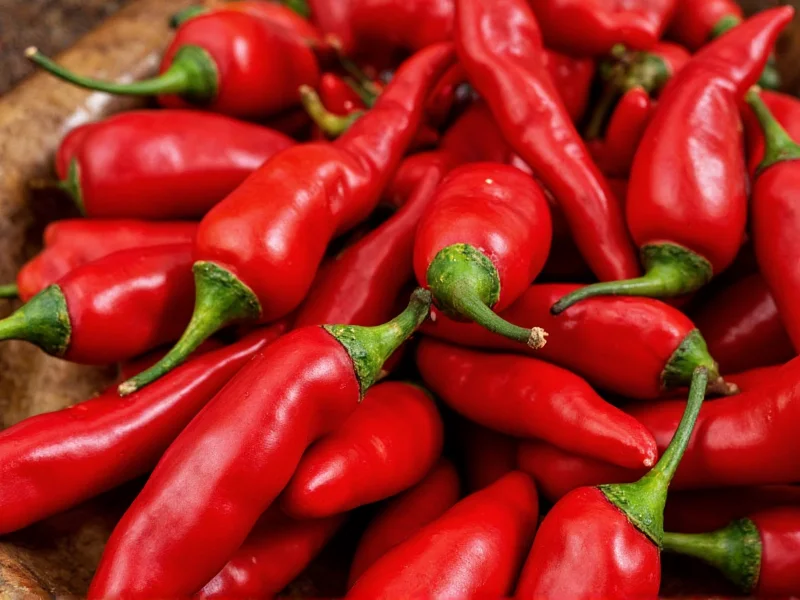Yes, ancho peppers are mildly spicy, registering between 1,000 and 2,000 Scoville Heat Units (SHU). They're significantly milder than common jalapeños (2,500-8,000 SHU) and offer a complex flavor profile with notes of dried fruit, coffee, and tobacco alongside their gentle heat.
Understanding Ancho Pepper Heat Levels
When exploring how spicy are ancho peppers, it's essential to understand their position on the Scoville scale. Anchos, which are dried poblano peppers, fall firmly in the mild to medium-low heat category. This makes them accessible to most palates while still providing that characteristic chili warmth that enhances dishes without overwhelming them.
The mild heat level of ancho peppers explains why they're so popular in Mexican cuisine and beyond. Unlike their fresh poblano counterparts, the drying process concentrates flavors while maintaining that approachable heat level that works well in sauces, stews, and rubs.
| Pepper Type | Scoville Heat Units (SHU) | Heat Level |
|---|---|---|
| Ancho Pepper | 1,000-2,000 | Mild |
| Jalapeño | 2,500-8,000 | Moderate |
| Serrano | 10,000-23,000 | Hot |
| Habanero | 100,000-350,000 | Very Hot |
| Bell Pepper | 0 | None |
Historical Evolution of Ancho Pepper Usage
The culinary journey of ancho peppers spans millennia, evolving from ancient preservation techniques to global kitchen staple. Archaeological evidence from the Tehuacán Valley confirms chile domestication in Mesoamerica around 6000 BCE, with drying practices emerging as critical food preservation methods in pre-Hispanic cultures (Chile Pepper Institute, New Mexico State University). The specific transformation of poblano peppers into anchos became codified in 16th-century Puebla, Mexico, where indigenous techniques merged with Spanish culinary traditions to create mole poblano. By the 19th century, anchos were documented in regional cookbooks across central Mexico, and their international proliferation accelerated during the 1970s-1990s as American culinary media spotlighted authentic Mexican cuisine. This historical trajectory explains their enduring role as flavor anchors rather than heat sources in complex dishes.
Factors That Influence Ancho Pepper Heat
Several elements affect the perceived heat of ancho peppers, making the ancho pepper heat level somewhat variable:
- Growing conditions: Soil quality, climate, and water availability impact capsaicin production
- Ripeness at harvest: Fully mature red poblanos (which become anchos) tend to be slightly hotter
- Preparation method: Removing seeds and membranes reduces heat significantly
- Individual sensitivity: Personal tolerance to capsaicin varies widely among consumers
Interestingly, the drying process that transforms fresh poblanos into anchos doesn't increase the capsaicin content but does concentrate flavors, which can make the heat seem more pronounced in certain preparations.
Ancho Peppers vs. Other Common Chili Peppers
When comparing ancho vs jalapeño heat, the difference becomes immediately apparent. A typical jalapeño ranges from 2.5 to 8 times hotter than an ancho pepper. This makes anchos an excellent choice for those who want to add authentic chili flavor to dishes without excessive heat.
Unlike cayenne or serrano peppers that deliver immediate, sharp heat, ancho peppers provide a slow-building warmth that complements rather than dominates other flavors. This characteristic makes them particularly valuable in complex sauces like mole, where their earthy, slightly sweet notes balance the heat.
The Complete Flavor Profile of Ancho Peppers
Focusing solely on ancho pepper Scoville rating misses their most valuable culinary contribution: a rich, complex flavor profile. Beyond their mild heat, anchos offer:
- Notes of dried fruit (particularly raisins and figs)
- Subtle coffee and chocolate undertones
- Earthy, tobacco-like qualities
- A slight natural sweetness
- Smoky depth (especially when toasted)
This multidimensional flavor explains why professional chefs and home cooks alike prize ancho peppers for adding depth to dishes. They're not just about heat—they're about creating layered, sophisticated flavors that mild chili peppers for cooking rarely achieve.
Contextual Usage Boundaries: Optimal Applications and Limitations
Understanding ancho peppers' functional boundaries prevents culinary missteps. While exceptionally versatile, they face specific constraints:
- Texture limitations: Their dried nature makes them unsuitable for fresh applications like salsas where crisp texture is essential (Texas A&M AgriLife Extension)
- Heat ceiling: Dishes requiring intense spiciness (e.g., Louisiana hot sauces) need supplementation with cayenne or habanero
- Rehydration dependency: Whole anchos require 20+ minutes soaking, complicating time-sensitive preparations
- Flavor dominance: Robust earthy notes overwhelm delicate dishes like seafood ceviche or light vegetable preparations
Texas A&M AgriLife Extension confirms dried chiles are "best utilized in cooked dishes with sufficient time for rehydration and flavor integration, rather than fresh applications" (Source). This contextual awareness maximizes their contribution to appropriate dishes like slow-simmered moles or spice rubs.
Practical Uses for Ancho Peppers in Your Kitchen
Understanding that dried poblano peppers (anchos) are only mildly spicy opens up numerous culinary possibilities:
- Rehydration: Soak in hot water for 20 minutes before blending into sauces
- Dry rubs: Combine with other spices for meats (especially pork and chicken)
- Mojo sauce: Blend with garlic, vinegar, and oil for a versatile condiment
- Stews and braises: Add whole or ground for depth of flavor
- Chocolate pairings: Their natural cocoa notes complement chocolate beautifully
For those concerned about heat levels, remember that removing the seeds and inner membranes before use will further reduce the already mild spiciness while preserving the distinctive ancho pepper flavor profile.
Why Ancho Peppers Are Kitchen Staples
The enduring popularity of ancho peppers stems from their versatility. Unlike extremely hot peppers that limit their use to specific applications, anchos work across countless recipes. Their mild heat means you can use them generously to build flavor without worrying about making dishes inedibly spicy.
When exploring using ancho peppers in recipes, consider them as flavor enhancers rather than heat sources. This mindset shift allows you to appreciate their contribution to dishes beyond just spiciness—something many home cooks miss when focusing solely on the heat question.











 浙公网安备
33010002000092号
浙公网安备
33010002000092号 浙B2-20120091-4
浙B2-20120091-4